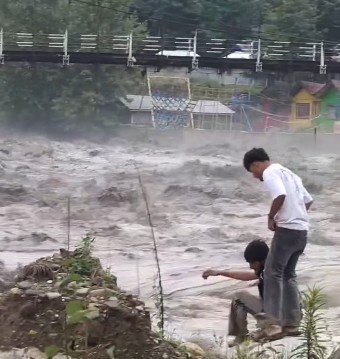With the onset of the monsoon bringing both relief and anxiety, the state of Punjab has been placed on high alert ahead of an intense spell of rainfall forecasted between July 5 and July 10, 2025. The Provincial Disaster Management Authority (PDMA), in coordination with the India Meteorological Department (IMD), has issued red and orange alerts for several regions, warning of heavy to very heavy rainfall, flash floods, lightning strikes, and potential landslides in certain hilly border areas.
The advance warning follows an updated weather bulletin that signals a concentrated low-pressure system over northern India, drawing in significant moisture from the Bay of Bengal and the Arabian Sea. This convergence is expected to unleash consistent showers across much of Punjab, with localised cloudbursts not being ruled out. Authorities fear that the cumulative rainfall over the five-day period could lead to urban flooding in low-lying cities like Ludhiana, Jalandhar, and Amritsar, while villages near rivers and canals may face overflows and waterlogging.
Deputy Commissioners in over 11 districts, including Patiala, Hoshiarpur, Ropar, Mohali, and Ferozepur, have been instructed to activate emergency response protocols. NDRF and SDRF teams are being stationed strategically across flood-prone zones. Leave for all district-level disaster management and irrigation staff has been cancelled until further notice.
Punjab’s Water Resources Department has also been put on high alert, with engineers monitoring the embankments of the Sutlej, Beas, and Ghaggar rivers. The Bhakra Dam and Pong Dam authorities have been directed to manage reservoir discharge carefully, particularly in case of sudden inflow surges. Farmers have been advised to temporarily suspend irrigation from canals and protect standing paddy crops by building embankments or water-diversion dykes around fields.
Meanwhile, the power department is reviewing vulnerable electric poles and transformer stations, especially in rural and semi-urban areas, to mitigate blackout risks from lightning strikes or water-induced short circuits.
“We are not taking any chances. Instructions have been issued to all departments for coordinated action. Our priority is to ensure the safety of life and property,” said Chief Secretary Anurag Verma in a late-night emergency briefing. He added that community halls and school buildings would serve as makeshift shelters if evacuations become necessary.
Weather experts warn that this week could witness rainfall levels exceeding the monthly average for July within just four to five days. “We expect rainfall in the range of 70–120 mm per day in some regions, which is significantly higher than the safe threshold,” said Dr. Anupama Singh, a senior scientist at IMD Chandigarh. She also warned of “cloud-to-ground lightning strikes,” particularly in areas like Pathankot, Fazilka, and Bathinda.
Urban authorities in Ludhiana and Jalandhar, two of the most densely populated cities in Punjab, are racing against time to unclog storm drains and clean up water outlets that have remained neglected since last monsoon. Last year’s flooding in Ludhiana’s Civil Lines and Jalandhar’s Rainak Bazar caused damages running into crores, and officials are under pressure to avoid a repeat.
On the public safety front, the Punjab Police have issued advisories against traveling during peak rainfall hours, venturing near riverbanks, or using underpasses. Schools have been given the option to switch to online classes if water levels rise in their vicinity. Punjab State Power Corporation Limited (PSPCL) has also urged citizens to stay away from electric poles and transformer units during heavy rain.
This monsoon, while crucial for Punjab’s agriculture-dependent economy, is already testing the preparedness of civic and state authorities. The outcome over the next few days will determine whether the state can avert the kind of disasters witnessed in past years when monsoon preparedness lagged behind the intensity of nature’s fury.
As the skies darken over Punjab, vigilance, community cooperation, and swift administrative response will be key to navigating the impending deluge safely.
#PunjabRainAlert #Monsoon2025 #FlashFloodsPunjab #IMDWarning #PunjabWeather #DisasterPreparedness #ClimateCrisisIndia #HeavyRainPunjab #FloodWarning #PunjabNews
This is an auto web-generated news web story.





